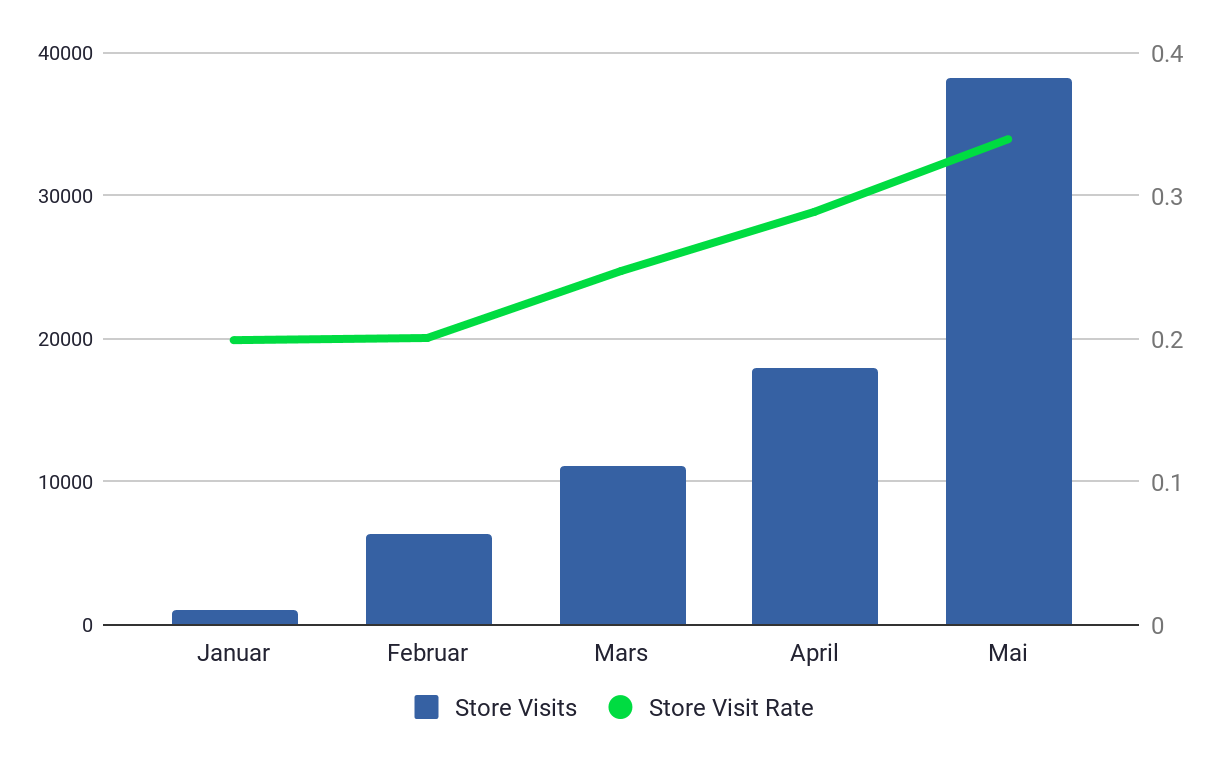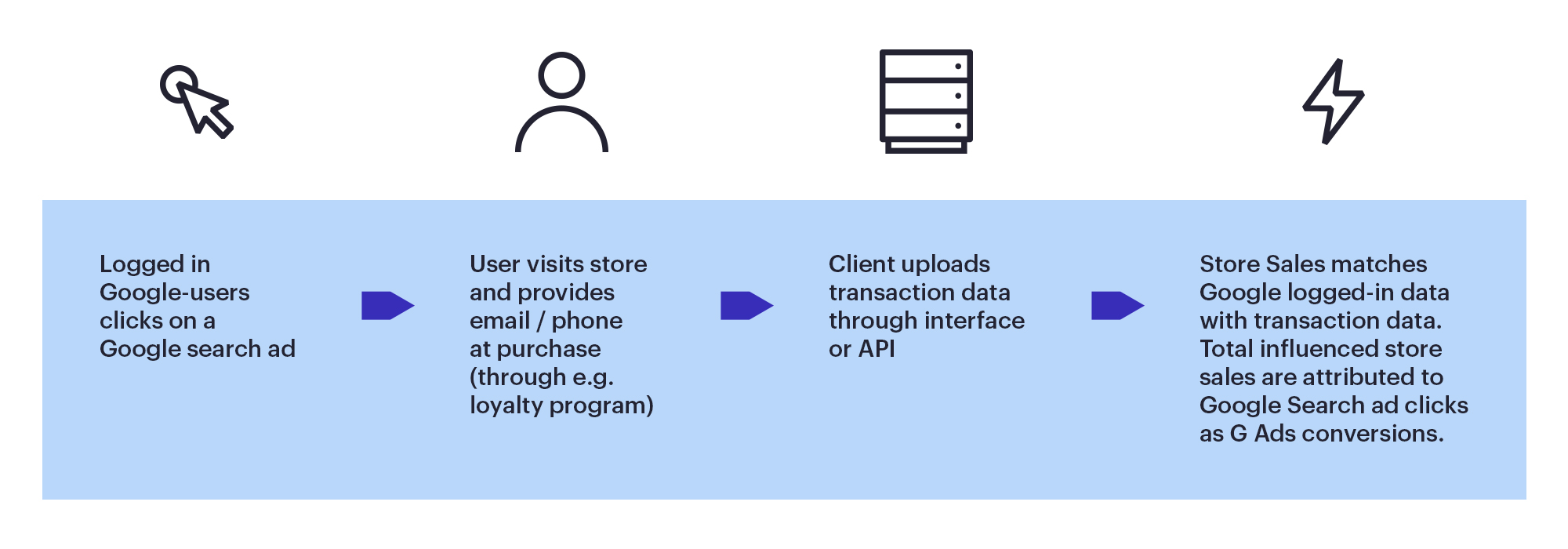How to create an online strategy for in-store shopping with Google

Herman Aatangen
Client Director
Although the online world is growing rapidly and digital media buying is taking up an ever-larger slice of the marketing cake, offline foot-fall is still at the heart of many business models across the globe. However, we don’t always see marketing strategies reflecting this information.
Measuring in-store visits online
In 2014, Google introduced the possibility to measure offline store visit conversions, thereby allowing advertisers a better understanding of the impact of Google Ads activities on driving foot traffic. A lot has happened since, and today we know this as the store visit conversion. To put it simply, a store visit occurs whenever a user clicks your ad and later visits any of your brick and mortar locations. But how is Google able to measure in-store visits?
- Google’s Maps team will not only map out the location of a store, but also the shape and coordinates of that store.
- Google combines this Maps data with signals coming from GPS, cell towers and WiFi.
- Lastly, a survey of over one million users helps in determining the level of accuracy Google is able to report on Store Visits.
These initiatives have resulted in a high degree of accuracy and reliability for Store Visits conversions (according to Google: ‘99 per cent accurate’).
Building Google Ad accounts for in-store visit success
As we now know, Store Visits as a conversion optimisation goal has been available for quite some time. The question is – how do we make the most out of it? There are, of course, several ways of doing so, but there is one important thing to clarify before building a strategy to maximise Store Visits value: Is there a difference between how you value an offline and online conversion, and if so, how should you prioritise these?
- If you have an ecommerce store and physical stores and define these as equally important you would take an omnichannel approach. In the world of Store Visits conversion tracking, this would mean you include a store visit as a normal conversion in conversion tracking, and allow Google Smart Bidding to optimise for both online and offline purchases.
- However, if your primary source of revenue (and therefore priority) is from physical stores your main conversion should be store visits. Your account structure and optimisation processes should therefore reflect this.
As mentioned previously, there is no definitive blueprint for Store Visits optimisation, but there are some examples of how this can be performed for in-store brands.
How to optimise your Google Ad Account Structure
It’s important to build one set of campaigns for all users and one set of campaigns for users geographically close to one of your stores. Taking this ‘Hyperlocal’ approach has proven very effective as it allows you to prioritise users based on proximity to the store. Since Google allows you to include store visits as a conversion to optimise towards in Smart Bidding strategies, the prioritisation of users based on proximity to stores becomes more automated and efficient.
You can read more about how Precis has built successful Store Visits strategies for Arken Zoo and Biltema here.
Google’s efforts to help measure offline has resulted in several new campaign types that have been developed. The two most relevant are Local Campaigns and Local Inventory Ads (LIA), both of which have the sole purpose of driving foot traffic to physical stores.
- Local campaigns are great for upper- and mid-funnel activities with an end-goal of driving store visits. This campaign type is designed to help users decide how to and when to visit their store. It will allow advertisers to be visible on search results, GDN, YouTube and maybe most interestingly – Google Maps. While the format below demands quite an extensive technical set-up using different feeds, the local campaigns format only needs location information from Google My Business.
- Local Inventory Ads (LIA) are more lower-funnel as this is based on search terms and is a great driver of foot-traffic. In Biltema’s case, we saw that LIA can actually drive Store Visits at less than 50% the cost per store visit compared to the rest of the account. However, it is important to keep in mind that LIA can start off quite slow, but that over time can prove to be one of the most important channels for Store Visits-focused clients.

Reporting and Gathering Insights for ad optimisation
Measuring offline conversions such as store visits is not only good for driving more conversions, but it’s also a great source for valuable insights. Once we take a more holistic approach and measure more aspects of our business, the learnings we can draw from our activities increase significantly. Other than the obvious ability to track foot traffic from our online activities, we can go a long way in estimating the offline value coming from these activities. This will unfortunately not be 100% accurate, but it goes a long way in estimating what sort of value you are getting from offline conversions via Google Ads.
In order to measure offline impact you will need two metrics:
- Estimated offline conversion rate (EOC), which is an estimation of how many visitors you’ll need to your store per in-store transaction, in other words in-store transactions/ total store visits.
- Average order value (AOV) of in-store transactions.
Using these two estimates, we can calculate approximately how many in-store transactions we are getting, and by multiplying estimated offline conversion rate with the AOV we are able to get an estimated offline revenue (EOR).
EOC x AOV ≈ EOR
With all of these numbers in place, we can easily divide the estimated offline revenue by the ad costs, giving us an approximate ROI.
To visually demonstrate an estimate of how offline value is affected by online marketing activities, add these metrics to your reporting dashboard. In this example, we used Google Data Studio and created custom fields for our new metrics:

In addition to this approach, we can also learn more about the client’s product range, and which categories and products drive online revenue and which drive more foot traffic. An example of this would be a sporting goods store, a biking category might see most sales in-store and categories such as clothing and shoes could drive more revenue online. However, by fully utilising our store visits data we can actually provide the client with insights confirming or debunking that hypothesis.
Insights, such as these, are beneficial in discussions concerning segmentation and targeting of products and categories for the client. We will be able to better decide which products to push online and which will be drivers of foot traffic to their stores.
Advanced offline conversion tracking
While the strategy mentioned above can be very useful, the resulting estimates are just that – estimates. However, there are opportunities if you want to take it one step further, and measure actual value from offline transactions. At Precis we have done this a few different ways, but the two main possibilities are:
- Implementing something called Store Sales (direct)
- Measurement Protocol in GA to fetch data directly from server-side.
Store Sales (direct upload)
Through this feature, Google allows you to import offline transactions from your physical stores directly into Google Ads. In a nutshell, you match transaction data from your database or loyalty program and use that data to deduce the impact Google ads has had on offline revenue.
In order to implement this feature, there are three things you need to have implemented in advance: User-ID in GA, whitelisting for the feature, and the data available in the format pre-defined by Google and of course within their data policies… When this is in place, you are ready to implement this in your Google Ads account. Read more about how to implement Store Sales (direct) here. An example of how this could work would look something like this:

Measurement Protocol
Utilising measurement protocol to fetch transaction data from physical stores allows us to import data from these stores directly into Google Analytics. This is a clear advantage when comparing to store sales (direct), as that is a Google Ads feature, and this implementation works for Google Analytics.
In other words, we will be able to get in-store transaction data directly into Google Analytics. The idea here is to send offline data as events to GA using Measurement Protocol. An HTTP POST request will be sent to GA when an offline sale is registered in the backend. This implementation is rather technical and extensive, so please feel free to ask us any questions if you want to learn more about this.
Facebook offline conversions
Thus far we have only discussed how we can use Google Ads or Google Analytics for offline advertising and tracking, however, there are a few possibilities within the paid social universe as well. Using something called Facebook offline conversions, you are able to upload staples data to facebook and match these transactions with impressions and clicks that happened on Facebook and Instagram.
Setting up this means you will need to format the data according to Facebook’s specifications, which can potentially be a bit time-consuming, but it is definitely worth exploring for most retailers. A downside when looking at Paid Social capabilities compared to Google’s is that you do not have the same ability to track store visits based on GPS signals, but this feature is coming and is currently in beta.
Strategy
In a process of extensive implementations and strategic changes, it is important to revisit the core query; how will we use offline conversion data that we now have access to? There are two main possibilities when it comes to a strategic approach and how we build and optimise our advertising accounts:
- The first one is to separate the physical store from online conversions, meaning that we value them differently and set different targets for both.
- The second option is to take an omnichannel approach in which we set one combined target using both online and offline revenue. Which strategy to select depends on several factors, but most importantly how you value online vs. offline, and if there is a significant difference between the two.
Final Thoughts
The global pandemic has taken its toll on brick and mortar stores, and many digital marketing experts suggest that a lot of revenue will shift to ecommerce. Nevertheless, according to a survey conducted by Marketing Land, the extreme ecom growth might not be so one-sided after all and that offline stores will still play an important role going forward. Google suggests that 90% of shoppers who visited a physical store in the last week did online research prior to visiting, meaning that effective online activities will still be essential for driving foot traffic in the future.
It is therefore important not to underestimate the importance of a good omnichannel strategy, or how online influences offline and vice versa. While the above-mentioned strategies won’t allow you to measure the full picture of offline and online activities (and their effects on each other), it will at the very least give you a push in the right direction.
Get in touch with us to learn more about offline and online attribution or learn more about attribution 2.0. with our 5 part series.


